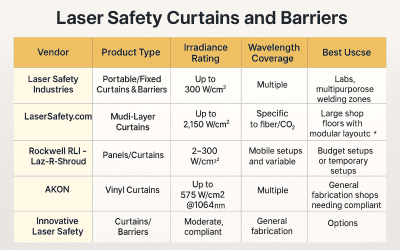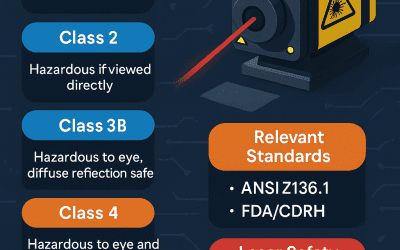Laser Welding Safety: PPE, Training, and LSO Comprehensive Guide
Comprehensive Laser Welding Safety Guide: Protecting Operators and Workspaces
What Are the Key Laser Welding Safety Hazards to Know?
Laser welding is a precision-intensive process widely used across manufacturing, automotive, aerospace, and medical device industries. But with high precision comes high risk—laser welding systems, especially those using Class 4 lasers, present a range of hazards that must be actively controlled to ensure a safe working environment.
One of the primary hazards is exposure to laser radiation. Depending on the wavelength, laser beams used in welding may be invisible to the human eye and capable of causing permanent eye injury or serious skin burns. Direct beam exposure, diffuse reflections, or even scattered radiation can exceed Maximum Permissible Exposure (MPE) thresholds in a fraction of a second. As such, all personnel in or near the weld zone must wear laser safety eyewear with the appropriate optical density (OD) and ensure that beam enclosures or curtains are in place to confine the Nominal Hazard Zone (NHZ).
A second critical hazard is the generation of hazardous airborne contaminants. The intense heat from laser-material interaction can vaporize base metals, coatings, and fillers, producing laser-generated air contaminants (LGACs)—a mixture of toxic fumes, metal particulates, and ultrafine aerosols. Without proper control, these airborne hazards can pose serious respiratory risks. Local exhaust ventilation (LEV), fume extractors, or downdraft tables should be used at the point of origin to minimize operator exposure.
The risk of fire is also significant. Laser welding produces high heat and can ignite nearby flammable materials—including rags, vapors, or accumulated dust. ANSI and NFPA guidance recommend maintaining a clean, clutter-free workspace, using non-combustible shielding, and keeping fire extinguishers rated for electrical and metal fires within arm’s reach.
Addressing these hazards through a combination of engineering controls, PPE, and procedural safeguards is essential to building a compliant and safe laser welding operation.
Which Risks Do Laser Welders Face During Operation?
Operators of laser welding systems face multiple concurrent risks, many of which are amplified by the high power density and localized heat produced by Class 4 laser equipment.
The most immediate and dangerous risk is direct or reflected laser radiation. Accidental exposure—whether due to alignment error, equipment failure, or procedural oversight—can cause permanent eye damage or thermal burns. This is why laser safety goggles rated for the system’s exact wavelength and power output are required, along with flame-resistant clothing, gloves, and full PPE when inside the Laser Controlled Area (LCA).
Thermal risks are equally present. Laser welding generates sparks, molten metal, and spatter, which can burn skin or start fires if proper barriers, shields, or protective clothing are not used. Operators should also be trained in lockout/tagout (LOTO) procedures to prevent unexpected startup during maintenance or adjustments.
Another significant hazard is inhalation of welding byproducts. Depending on the material being welded, operators may be exposed to hexavalent chromium, lead, zinc oxide, or other harmful substances. OSHA and NIOSH recommend air monitoring, exposure assessment, and the use of local ventilation systems to keep airborne concentrations below occupational exposure limits.
Mitigating these risks requires more than PPE alone. It calls for a comprehensive laser safety program, which includes:
-
System-specific hazard evaluations
-
Regular training and retraining on laser and welding safety
-
Incident reporting procedures and near-miss analysis
-
Coordination with the Laser Safety Officer (LSO) to ensure compliance with ANSI Z136.1, OSHA, and other applicable standards
By addressing these hazards with layered safety controls, organizations not only protect their operators—they build a safer, more efficient welding process.
How Does Laser Radiation Affect Skin and Eyes?
Laser radiation poses serious risks to both skin and eyes, especially in high-power laser applications such as welding, cutting, and clinical procedures. The degree of risk depends on the wavelength, power level, and duration of exposure.
Skin Hazards
Laser exposure to the skin can lead to thermal injuries ranging from mild reddening to deep burns. In clinical settings, controlled thermal damage is used therapeutically (e.g., laser resurfacing), but unintentional exposure—especially to Class 3B or Class 4 systems—can result in:
- Burns or blisters from absorbed heat
- Pigmentation changes or scarring
- Delayed healing due to cellular disruption
Skin absorption varies by wavelength. For example, far-infrared lasers may cause surface heating, while visible and near-infrared beams can penetrate deeper, damaging underlying tissues. Proper PPE such as flame-resistant gloves and long-sleeve protective clothing should always be worn when working near active laser systems.
Eye Hazards
The eye is significantly more vulnerable to laser injury due to its optical focusing mechanism, which can concentrate incoming radiation onto the retina, increasing power density by up to 100,000 times. Retinal exposure—especially from visible and near-infrared lasers (400–1400 nm)—can result in:
- Retinal burns and permanent vision loss
- Corneal or lens damage from UV or far-IR wavelengths
- Flash blindness or glare-induced visual disruption
These injuries can occur within milliseconds, even from diffuse reflections. Laser safety eyewear (LPE) rated for the laser’s specific wavelength and optical density (OD) is mandatory in any Laser Controlled Area (LCA).
Professionals working with or near lasers—and individuals undergoing clinical laser treatments—must adhere to ANSI Z136 safety standards to minimize biological risk. Proper training, PPE, and exposure control measures are non-negotiable.
What Are Common Environmental and Fire Hazards in Laser Welding?
Laser welding introduces a range of environmental and fire hazards that must be managed proactively to maintain a safe workspace.
Airborne Contaminants
The laser welding process generates Laser-Generated Air Contaminants (LGACs)—metallic fumes and particulates produced by vaporized materials. These contaminants may contain:
- Heavy metals like chromium, nickel, or manganese
- Alloying elements or surface coatings that release toxic compounds
- Ultrafine particles that penetrate deep into the lungs
Exposure to LGACs can result in respiratory irritation, chemical toxicity, or long-term health issues. Facilities must install local exhaust ventilation (LEV) and monitor air quality to comply with OSHA exposure limits. Where necessary, respiratory protection may be required as part of a comprehensive PPE plan.
Fire Hazards
Laser beams, particularly from Class 4 systems, can ignite flammable materials either directly or via beam reflections. Common fire risks in laser welding include:
- Combustible debris, rags, or packaging near the beam path
- Flammable gases, vapors, or lubricants used in nearby operations
- Accumulated dust or metal fines in poorly maintained environments
To control these risks, facilities should:
- Use fire-resistant barriers and curtains
- Keep the work area free of combustible clutter
- Equip the area with fire extinguishers rated for Class C and D fires
- Provide fire safety training and integrate emergency response plans
Regular equipment inspections, beam path assessments, and compliance with ANSI Z136.1 and NFPA 51B welding safety protocols help reduce both ignition sources and fuel load.
How to Establish and Control a Safe Laser Welding Area
Establishing a safe laser welding area begins with a comprehensive hazard assessment and a firm understanding of the laser classification, power output, and beam path. According to ANSI Z136.1, facilities using Class 3B or Class 4 lasers are required to designate a Laser Controlled Area (LCA) where access and exposure are strictly managed.
The first step is to evaluate the workspace for potential hazards:
- Remove combustible materials from the beam path
- Ensure surfaces are clean, non-reflective, and free of obstructions
- Mark the area clearly with ANSI-compliant signage identifying the laser hazard class and required PPE
Next, engineering controls must be implemented:
- Install barriers, laser curtains, or beam enclosures to contain the beam within the defined Nominal Hazard Zone (NHZ)
- Use interlock systems to disable the laser when entry points are breached
- Maintain ventilation systems to capture and extract Laser-Generated Air Contaminants (LGACs) from the weld zone
Personnel working in the area must wear laser safety eyewear rated for the laser’s wavelength and optical density, along with flame-resistant clothing and thermal-protective gloves. All staff must undergo laser safety training tailored to their role, and periodic drills and reviews should be conducted to ensure emergency preparedness.
Regular equipment inspections, system maintenance, and beam alignment checks are also essential to reduce the risk of malfunction or accidental exposure. By integrating these layers of protection, facilities can maintain operational efficiency while keeping personnel and equipment secure.
What Defines a Laser Control Area and Its Safety Requirements?
A Laser Control Area (LCA) is a designated space where Class 3B or Class 4 laser operations are performed, requiring a specific set of administrative and engineering controls to ensure personnel safety. LCAs are defined by their boundary conditions, often enclosed with physical barriers, and are managed by the Laser Safety Officer (LSO) in accordance with ANSI Z136.1.
The purpose of an LCA is to:
- Restrict access to authorized and trained personnel only
- Control and contain the beam to prevent accidental exposure
- Ensure that hazard signs, PPE requirements, and emergency protocols are clearly communicated
Minimum safety requirements for an LCA include:
- Warning signs posted at all entry points
- Access control measures such as keyed entry, badge systems, or interlocks
- Use of laser protective eyewear (LPE) for anyone within the Nominal Hazard Zone (NHZ)
- Beam enclosures, laser curtains, or apertures to limit exposure
- Standard Operating Procedures (SOPs) that detail alignment procedures, emergency shutdown protocols, and startup checklists
Additional safety systems, like remote interlocks, status indicators, and emergency stop buttons, further enhance control within the LCA. Regular training and documentation reviews are necessary to ensure that all protocols stay up to date with changes in equipment or process requirements.
By enforcing these standards and maintaining a well-defined LCA, organizations can effectively manage laser-related risks, maintain compliance with regulatory standards, and foster a culture of preventative safety.
How to Use Laser Welding Enclosures and Barriers Effectively
Proper use of laser welding enclosures and barriers is critical for maintaining a safe and compliant workspace—particularly when working with Class 4 laser systems, where beam exposure poses significant risk to personnel and equipment. These systems not only protect workers from harmful radiation and airborne contaminants, but also support consistent weld quality by maintaining environmental control around the work zone.
Laser Welding Enclosures
Laser welding enclosures are engineered to:
- Contain laser radiation within a defined area
- Prevent escape of stray beams or reflections
- Support ventilation and fume extraction systems for controlling LGACs (Laser-Generated Air Contaminants)
To be effective, enclosures must:
- Be constructed from laser-rated materials that match the system’s wavelength and power
- Include seals and interlocks to eliminate gaps and ensure automatic beam shutoff when access points are opened
- Provide viewing windows made from optically filtered materials with clearly marked optical density (OD) ratings
Operators should verify that enclosures are inspected regularly for damage or degradation and that airflow systems are functioning properly. Clean internal environments reduce contamination that can degrade beam quality or pose combustion risks.
Laser Safety Barriers
Barriers delineate Nominal Hazard Zones (NHZ) and prevent unauthorized or accidental access to active laser areas. Strategic placement of portable or fixed barriers around open-beam applications helps:
- Control workflow
- Reduce distractions
- Limit access to trained personnel only
Barriers should be rated for the expected laser class and wavelength, and must be used in combination with warning signs and restricted access protocols.
Integrating interactive controls, such as remote viewing displays, emergency stop buttons, or access badges, allows operators to manage workflow safely without interrupting laser containment.
By combining enclosure integrity, barrier placement, and real-time system controls, facilities can enhance both safety and productivity in laser welding operations.
Which Warning Signs and Access Controls Are Essential?
In any Laser Controlled Area (LCA), properly implemented warning signs and access controls are essential for protecting personnel from laser radiation hazards and maintaining regulatory compliance.
Warning Signs
According to ANSI Z136.1, warning signage must:
- Clearly identify the laser class, wavelength, and required optical density (OD)
- Include signal words (e.g., “Caution,” “Danger”) based on hazard classification
- Be conspicuously posted at all entry points to the LCA
Signs may also include operational status indicators such as:
- “Laser in Use” with flashing lights or audible tones
- Instructions like “Do Not Enter When Light Is On” or “Eye Protection Required”
ANSI Z136.1 also allows inclusion of contact info for the Laser Safety Officer (LSO) and procedural instructions, such as knock-before-entry or alignment precautions.
Access Controls
Access to laser areas must be limited to trained and authorized personnel, especially for Class 3B and Class 4 systems. Effective access control strategies include:
- Non-defeatable interlocks that disable the laser when a door or panel is opened
- Badge readers or biometric systems to authenticate entry
- Administrative controls, such as logs, training validation, or escorted entry protocols for visitors
Together, warning systems and access controls form a layered defense that supports operator awareness and prevents unauthorized exposure. When installed correctly and audited regularly, these controls contribute to a defensible, ANSI-compliant laser safety program.
What Personal Protective Equipment (PPE) Is Required for Laser Welding Safety?
Personal Protective Equipment (PPE) is a critical component of any laser welding safety program, especially when operating Class 3B or Class 4 lasers, which present significant hazards from both direct and scattered radiation, as well as thermal and airborne risks.
Core PPE Requirements:
- Laser Safety Eyewear (LPE)
- Must be rated for the wavelength and optical density (OD) of the laser system in use.
- Should meet or exceed standards specified in ANSI Z136.1 and carry clear labeling for verification.
- Face Shields or Welding Helmets
- Often used in combination with LPE for full-face protection, especially in high-exposure environments.
- Must include appropriate OD-rated filters for multi-beam or high-power systems.
- Flame-Resistant Clothing (FRC)
- Operators should wear long-sleeved, fitted, non-synthetic garments made from flame-resistant materials (e.g., Nomex®, Kevlar®).
- Clothing should protect against sparks, molten spatter, and thermal emissions.
- Heat-Resistant Gloves
- Required for handling materials and fixtures heated during laser welding.
- Should provide a balance of thermal protection and dexterity.
- Respiratory Protection
- If Laser-Generated Air Contaminants (LGACs) are present, such as metal fumes or chemical vapors, NIOSH-approved respirators or local exhaust ventilation (LEV) must be used.
Regular PPE inspections, proper fit, and routine training on donning, doffing, and care procedures are essential to maintain effectiveness and compliance.
How to Choose the Right Laser Safety Eyewear for Different Wavelengths
Selecting the correct laser safety eyewear (LPE) is essential for protecting personnel from wavelength-specific ocular hazards. Not all eyewear is universally protective—each lens must be matched precisely to the laser’s operating wavelength and power.
Key Considerations for Eyewear Selection:
- Wavelength
Identify the exact wavelength (in nanometers) of the laser system. For example:- CO₂ lasers = ~10,600 nm (far-IR)
- Fiber lasers = ~1070 nm (near-IR)
- Nd:YAG = 1064 nm
- Diode lasers = 800–980 nm
- Visible spectrum lasers = 400–700 nm
- Optical Density (OD)
OD indicates the lens’s ability to attenuate laser radiation at the specified wavelength.- An OD of 5 reduces intensity by 100,000x.
- Higher-power systems require higher OD ratings.
- Eyewear must be clearly marked with OD and wavelength ranges.
- Compliance and Certification
Look for eyewear certified to ANSI Z136.1, EN 207/208 (Europe), or similar recognized standards. Verify manufacturer labeling and test data. - Fit, Comfort, and Visibility
PPE is only effective if it’s worn properly. Ensure eyewear is:- Comfortable for extended use
- Compatible with other PPE (e.g., helmets or face shields)
- Allows sufficient field of view for task performance
Always consult with the Laser Safety Officer (LSO) for final selection, and ensure eyewear is regularly inspected for damage, scratches, or lens degradation.
What PPE Should Surrounding Workers Use If They Are Within Eyeshot of the Laser Control Area?
Personnel near—but outside—the Laser Controlled Area (LCA) must also be protected if there’s a risk of diffuse reflection, accidental beam propagation, or airborne contamination.
Recommended PPE for Nearby Workers:
- Laser Safety Eyewear (LPE)
If there’s a chance that scattered or reflected beams could reach outside the LCA boundary, nearby workers must wear eyewear rated for the same OD and wavelength as those working inside the LCA. - High-Visibility Clothing
Enhances situational awareness and ensures that individuals are visible to laser operators and machine systems in shared workspaces. - Protective Lab Coats or Garments
Especially in lab or clinical settings, lab coats made from cotton or flame-resistant blends help protect against low-level spatter or heat exposure. - Respiratory Protection (as required)
If LGACs or chemical byproducts are not fully contained, surrounding workers may require ventilation support or NIOSH-approved filtering facepieces, depending on hazard assessments.
The LSO should assess whether the Nominal Hazard Zone (NHZ) extends beyond the LCA, and whether secondary exposure risks warrant expanded PPE coverage. Safety protocols should include training for adjacent staff and clearly marked barrier zones or signage for high-risk areas.
What Are Best Practices for Laser Welding Safety Training and Compliance?
Establishing a robust laser welding safety training program is essential for compliance, injury prevention, and operational efficiency. A well-trained team is better equipped to identify hazards, follow safety protocols, and respond to incidents effectively.
Key Best Practices Include:
- Role-specific training: All personnel—including welders, maintenance staff, and support workers—must receive training aligned to the laser class, wavelength, and application used in their workspace.
- Foundational instruction: Training should begin with core topics such as laser classifications, hazard recognition, beam path awareness, and non-beam hazards like fumes, reflections, and electrical risks.
- PPE education: Staff must be trained on selecting and using appropriate laser protective eyewear (LPE), flame-resistant clothing, and respiratory protection where needed.
- Hands-on exercises: Real-world simulations, including alignment protocols, emergency shutdown procedures, and incident response drills, enhance understanding and retention.
Training should follow a structured format defined by the Laser Safety Officer (LSO) and meet the standards set by ANSI Z136.1, OSHA, and applicable local regulations.
Compliance Maintenance:
- Conduct initial and annual refresher training
- Maintain training records for each employee
- Include safety updates in pre-task briefings or toolbox talks
- Perform routine safety audits and compliance checks
By integrating these best practices, organizations not only reduce the risk of injury—they also improve compliance posture, reduce downtime, and support a culture of continuous improvement.
What Topics Should Laser Safety Training Cover for Welders?
Laser welding training must be comprehensive and application-specific to ensure welders understand both technical risks and protective strategies. ANSI Z136.1 identifies key areas that must be included in any formal training program.
Core Topics:
- Laser fundamentals: Wavelengths, beam properties, classifications, and how these factors influence exposure risks
- Material interactions: Reflection, absorption, and transmission characteristics of metals and alloys commonly used in laser welding
- Biological effects: Potential injuries to eyes and skin, including mechanisms of thermal and photochemical damage
- Laser safety eyewear (LPE): How to select and maintain eyewear based on wavelength and optical density (OD)
- Protective clothing: Flame-resistant garments, gloves, and other PPE specific to thermal and beam hazards
- Work practices: Safe system setup, beam alignment procedures, workspace organization, and lockout/tagout (LOTO) principles
- Emergency procedures: Evacuation protocols, injury response, and laser incident reporting
Welders must understand not only how to use the equipment, but also how to recognize signs of malfunction, follow approved procedures, and respond to unexpected situations.
How Does Certified Laser Safety Officer (LSO) Training Enhance Workplace Safety?
Having a Certified Laser Safety Officer (LSO) is one of the most effective ways to maintain a safe, compliant laser environment. LSO training equips individuals with the knowledge to evaluate hazards, implement controls, and oversee laser use across all departments.
Benefits of Certified LSO Training:
- Hazard assessments: LSOs conduct MPE evaluations, define the Nominal Hazard Zone (NHZ), and determine appropriate PPE and interlock requirements
- Program oversight: LSOs are responsible for developing SOPs, maintaining documentation, and conducting routine audits and inspections
- Employee training: A certified LSO ensures that all personnel receive up-to-date safety instruction tailored to the laser systems in use
- Regulatory compliance: LSO training supports adherence to ANSI Z136.1, OSHA regulations, and state-level safety mandates
LSOs serve as the central point of coordination for laser safety, bridging technical expertise, regulatory compliance, and workforce training. Their presence is not just a requirement—it’s a strategic asset that strengthens accountability, awareness, and safety culture across the organization.
Final Thoughts
Laser welding offers unmatched precision and efficiency—but it comes with real, regulated risks. From beam exposure and airborne contaminants to electrical hazards and fire risks, every aspect of laser welding must be managed through a layered safety approach.
Establishing a compliant and effective program begins with hazard identification and control, guided by ANSI Z136.1 and supported by a trained team. The Laser Safety Officer (LSO) plays a pivotal role in evaluating risks, enforcing protocols, and ensuring all personnel—from welders to bystanders—understand their responsibilities.
Through proper PPE selection, laser safety training, and engineering controls, organizations can significantly reduce incidents, support regulatory compliance, and maintain a productive, safe working environment.
Laser safety isn’t optional—it’s foundational. A well-executed program protects people, equipment, and your operational future.




